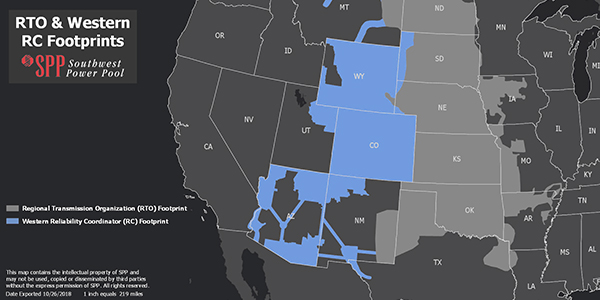By Tom Kleckner
SPP launched its Western reliability coordination service Tuesday afternoon, becoming the first regional transmission organization to handle RC services in both the Eastern and Western Interconnections.
The RTO said the transition from Peak Reliability, the Western Electricity Coordinating Council’s RC provider since it was separated from WECC in 2014, was seamless and took place at noon, Mountain Time.
SPP is now responsible for ensuring the bulk electric system’s reliability for 16 entities, representing about 12% of Peak’s legacy load: Arizona Electric Power Cooperative (AEPCO); Black Hills Energy utilities Black Hills Power, Cheyenne Light, Fuel and Power Co. and Black Hills Colorado Electric; City of Farmington (N.M.); Colorado Springs Utilities; El Paso Electric Co.; Intermountain Rural Electric Association; Platte River Power Authority; Public Service Company of Colorado (Xcel Energy); Tri-State Generation and Transmission Association; Tucson Electric Power; Western Area Power Administration (WAPA) Colorado River Storage Project Management Center; WAPA Desert Southwest Region; WAPA Rocky Mountain Region; WAPA Upper Great Plains-West.
The grid operator spent more than a year working with the companies to develop its Western RC services and manage their implementation. SPP established data connections to new customers, built out systems and processes and ensured everyone was ready for the transition.
“AEPCO commends the staff at SPP for the dedication and diligence required to successfully pull off a daunting task,” Arizona Electric’s executive director of system operations, Shane Sanders, said in a statement. “AEPCO appreciates the level of detail required to bring in the project on time and on budget without any unexpected surprises or hurdles. Hats off to a job well done.”
CAISO has been providing RC services for the vast majority of WECC since July. Like SPP, CAISO jumped at the opportunity to expand its services when Peak announced last year it would wind down operations at the end of 2019. (See CAISO RC Wins Most of the West.)
Canadian entities BC Hydro and the Alberta Electric System Operator are serving as RCs for their footprints, accounting for another 14% of the WECC’s load.
WECC CEO Melanie Frye called the transition a “major reliability milestone” and lauded Peak’s leadership and staff for providing “high-quality RC services” up until the last moment of Peak’s existence.
“The transition to multiple RCs represents a significant accomplishment for all new RCs, their customers, Peak Reliability, and the overall reliability and security of the bulk power system in the Western Interconnection,” she said.
“We greatly appreciate the work of Peak, CAISO and SPP to make the transition as smooth and seamless as possible,” said WAPA COO Kevin Howard.
SPP framed its Western RC services as “laying the foundation” for additional offerings as part of its Western Energy Services portfolio. The RTO already administers the Western Interconnection’s unscheduled flow mitigation plan for six utilities, and it will launch an energy imbalance service in 2021. (See WAPA, Basin, Tri-State Sign up with SPP EIS.)
NERC certified SPP’s RC services last month. (See NERC Certifies SPP as RC Provider in West.)
The RTO has been a NERC-certified RC in the Eastern Interconnection since 1997, managing about 40 GW of load. Its RC service territory now extends from the Canadian border to the Texas Panhandle.



